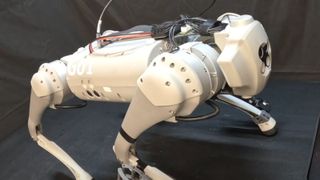Scientists have developed a quadrupedal robot that can use its two front legs to grasp and handle objects while walking on its hind legs.
Quadruped robots usually take the form of robot dogs, including Boston Dynamics’ Spot. They can traverse challenging terrain at speed and usually have low centers of gravity. Most object-manipulating quadrupeds have two extra arms that can grasp and hold objects – meaning they have a total of six “limbs”.
But the LocoMan robot is unique because it can switch from its four-legged position to a standing position and use its two front legs to manipulate objects. Scientists described how the robot worked in a study posted on March 27 THE arXiv preprint server.

“In this paper, we present LocoMan, a novel approach that enhances the manipulation dexterity of quadruped robots through the integration of lightweight engineered loco-manipulators, expanding their operating space and enabling precise control over complex 6D manipulation tasks ,” the scientists said in the paper.
LocoMotion
The design combines the mobility of a quadruped with the functionality of “manipulators,” which, in this case, refers to the hand-like parts on the robot that can control or manipulate an object. The key here is that the ability to handle objects has been developed without compromising LocoMan’s versatility.
However, its multi-functional legs also demonstrated dexterity in challenging environments, such as confined spaces and rocky terrain. with the robot exhibiting precise and stable movements during tasks that required “complex bi-arm coordination”. This sets LocoMan apart from other four-legged robots.
Connected: Watch a ‘robot dog’ crash through a basic AI-assisted parkour course
Its design took inspiration from the “anatomy of human arms”, the researchers said in their paper, with custom-made loco-manipulators using existing joints added to the calf area of the front legs.
These leg joints are similar to the elbow and shoulder joints in a human while the added joints share similarities with the human wrists. They incorporated four compact actuators (the components that control motion) that provide position, velocity, and torque feedback. To make the loco-manipulators more compact, the team designed the clamp as two pairs of gear-locked rotating jaws, enabling symmetrical opening and closing of the clamp with a single motor.
In order to seamlessly integrate the loco-manipulator with the existing four-legged robot structure, the joints had to be aligned and allow movement and grasping actions without either of these capabilities impeding the other.
The researchers evaluated LocoMan with real-world experiments, such as opening doors, pushing plugs into electrical outlets, and picking up objects in tight spaces. The team noted in the study that the robot completed all tasks and showed “remarkable agility.”
“Our research offers a different perspective of intelligent robots. Instead of replicating humans with a similar morphology, we would like to provide a complementary robot that can do what humans might not want to do,” said. Ding Zhao, an associate professor of mechanical engineering at Cornell University, in a statement. “LocoMan enables quadrupedal robots to perform complex manipulation tasks in tight spaces.”
Scientists now want to put LocoMan to the test in more challenging real-world environments and situations. They also plan to add computer vision and machine learning algorithms to the robot in their future research.

